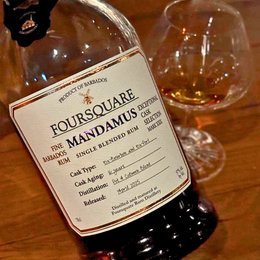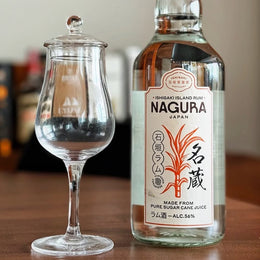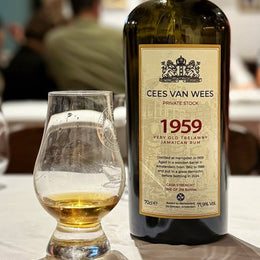
This one’s a unicorn, I’ve been told. And because it was primarily meant for the Japanese market (more on that later), and the only known bottle in Singapore was running at less than quarter of a bottle remaining, safe to say there was a slight urgency to get to it.
When I did get to it, it came in the form of green tinted bottle that looked a lot more like a wine bottle or maybe an old Islay Scotch bottle than what we’re used to with rums, and perhaps back then it made sense given wine and Scotch’s more domineering popularity.

The label was irreparably damaged, most of it was torn off, although still conspicuously leaving some key identifiers like the name of the expression, its provenance and vintage. Not the typical unicorn you’d envisaged – or maybe, unicorns are really just rhinos, and that realistically something as rare and old, this vestige of history dates back to 1952 for God’s sake, ought precisely to come into one’s hands like this. Could it have been any other way? Clean, perfectly preserved label, nah, you’d think it was fake. Well, that’s a lesson there folks, real unicorns gotta look the part.


In any case, there isn’t too much concretely known about this rhum – the Rhum Lapalun 1952, aside from the fact that it’s very old, was mostly for the Japanese market (some say the French market as well), was bottled by Chantal Comte and is supposedly a rhum from Martinique.
Chantal Comte is a prominent independent bottler, a lady who has built a somewhat cult following of rum lovers who’ve followed her from her works such as her bottlings from Trois Rivieres. Madam Comte herself owns a wine chateau in France and is said to have quite the familial connections in Martinique. She’s still active today by the way.
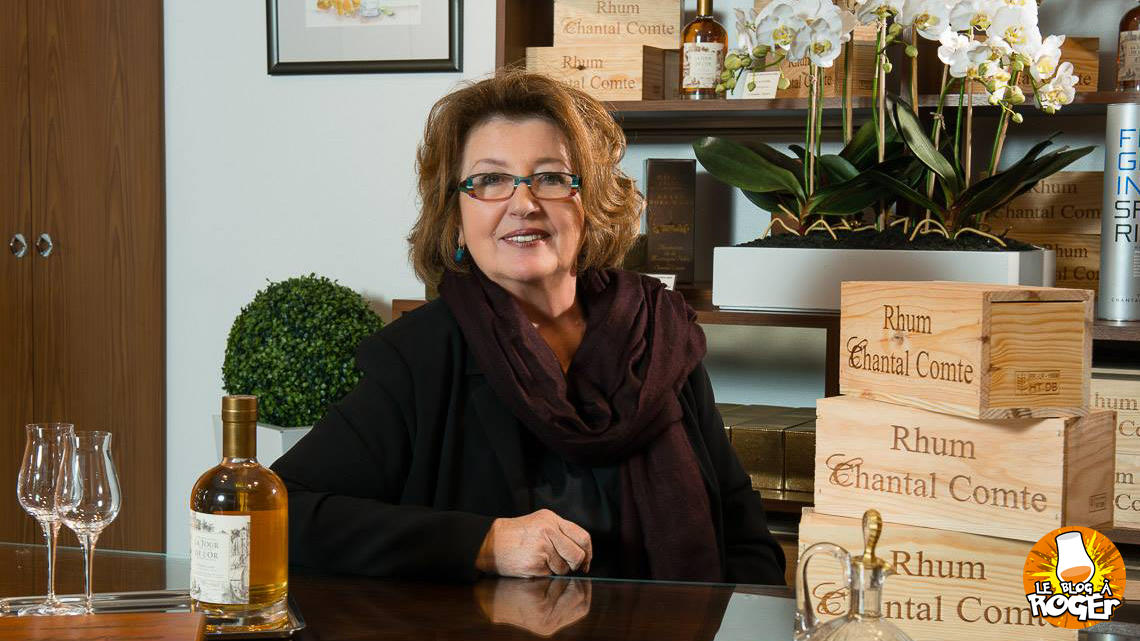
Madame Comte, likely the only person who knows the true provenance of this unicorn. (Image Source: Le Blog A Roger)
Regarding the bottles provenance, according to several rum reviewing pals, @weixiang_liu and John Go, their first hand research has led them to piece together that the Rhum Lapalun 1952 got to be predominantly found in Japan for one of two reasons or perhaps both reasons taking place sequentially. The first story comes from Comte herself, who mentions it being bottled on request of a Japanese customer in the 1980s and that it had actually originated from Habitation Clement in Martinique, with a total outturn of only 52 bottles. An alternative, or maybe a segue, into this origin story, is that the rhum was actually meant for the French market, but ended up in the hands of two Japanese importers, which is how the majority of them actually ended in Japan. From the second story, it seems as though the rhum was distilled in 1952 and bottled in 1970, although Comte’s version of the story would place it around the 80s instead. It is also mostly of consensus that there are in fact three different bottlings of the rhum, differentiated by the color of their stoppers.

Habitation Clement, where the Lapalun is rumoured to originate from, in Domaine de l’Acajou. (Image Source: hellolaroux)
It would seem strange that this would be produced at Habitation Clement though – if you’ve tried anything of the place, you’d know what I mean. Even optically, Habitation Clements rums never take on too dark a shade, they are always noticeably lighter in color. Of course, going back to the 1950s some of them do take on a much deeper mahogany hue but even so, nowhere near the dark burgundy of the Lapalun. I found this highly uncharacteristic.
Another aspect that leads me to believe this was probably a cask acquired or inherited by Habitation Clement is that the oldest Clement’s date back to 1950, which sits in the estate’s museum, with most available vintages only going back to 1952, which would mean that the Lapalun would be amongst Clement’s oldest vintages and yet were sold to Comte, which I find slightly unbelievable that the estate would relinquish some of their most prized juice to an independent bottler, no matter how connected.
The Guadeloupe National Park closer to Petit Bourg, where the rhum is from based on its label, about half an hour's drive from Habitation Clement. (Image Source: AllTrails)
Now, some may point to the obvious – if it were from Habitation Clement, it would simply be labelled as such, and not Lapalun, nor would it place its geographical provenance as Petit-Bourg, where Habitation Clement is actually located about a half hour’s drive away at Domaine de l’Acajou. To which I say, consider that records in 1950s Martinique are, without much guessing, not the most comprehensive. You’d be better off discovering a new tomb in Egypt’s famed Valley of the Kings than to trace down the exact provenance of a specific expression – at least you had the hieroglyphs to work with, here I have all of half a torn label.

With some light digital excavating, a Japanese blog tells me that Lapalun was actually from an estate called Lapalun Farm, which ceased distilling in 1955, after which the Comte family took over the remaining stock and bottled it in 1972, in which case there was no mention of Habitation Clement’s involvement. Although it’s very possible that when Lapalun Farm closed, the remaining stock was acquired by Clement and left in the estate’s storage until it was sold off (probably happy to clear off stock that wasn’t theirs) to Comte who later bottled it, which seems a fairly reasonable deduction.
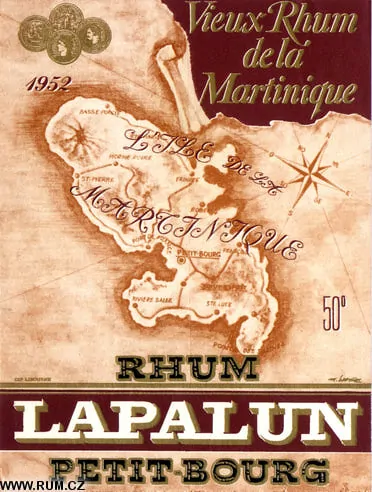
The original Lapalun 1952 label. (Image Source: Rum.cz)
Separately, according to John’s experience at Rum and Whisky Kyoto Bar, the prices of this bottle has fluctuated quite a fair bit and at one point was incredibly cheap. When it was first marketed it started off at 100,000 Yen but hit rock bottom due to lack of demand, going for about 3,000 Yen instead. The barkeep even once received an opened bottle from a customer who had preferred to give it away than to drink it, as it was too strong for the local Japanese palate.
Let’s see how this goes!

Rhum Lapalun 1952, Petit-Bourg, Martinique, Chantal Comte, 50% ABV – Review
Color: Burgundy

More Port wine than anything - big juicy sweet stone fruits - grapes, plums, well, Port! Goes on to raisins, apricots and more tart cherries.
On the nose: Sweet stone fruits – red grapes, prunes, plums, all in the form of juice or concentrate, akin to Port or red Zinfandel wine. Rich and saccharine, this continues in the form of figs and raisins and other dried stone fruits much in the way of blackberries, apricots and cherries. All very lush, rich and inviting – exceptionally accessible.

More tannins come through - macerated grape skins. Slew of earthier, richer notes emerge! Umami notes of miso, truffle and dried mushrooms. A mustier aroma of a fireplace, then with deep, bittersweet, rich aromas espresso, Christmas cake and dark chocolates.
There’s a more tannic side as well which offers a nice juxtaposition to the otherwise syrupy sweetness – grape must and balsamic, more specifically. Umami notes lace its aromas with fresh soil, truffle, miso and dried mushrooms – morels and porcini come to mind, as well as old cardboard, tobacco leaf and old leather. A lovely rich earthiness. There is as well a gentle toasty note of an old fireplace, and also espresso, Christmas cake and dark chocolates.

Lighter notes that just might make this a rhum agricole - sea coconut, grass jelly and tall grass - light, grassy, slightly herbal.
As it slowly blooms, lighter notes of sea coconut, grass jelly, as well as tall grass comes forth.

The palate is thinner than you'd expect - but maybe I was primed to expect Port wine. Never the less, more macerated stone fruit, wine notes, it gets more forest-like, of wet moss and wet stone, forest floors and fallen leaves.
On the palate: Thinner than you’d expect from its aromas and color, reminding you that as much as its aromas may deceive you to believe this is Port, it is in fact rhum (maybe even rhum agricole, which is generally agreed upon, but I still find difficult to believe). Texture aside, which by the way is quite smooth, its taste is still very much on Port wine – sweet, rich and lush, but surprisingly bright. Loads of macerated stone fruit – juice, concentrate, wine. There’s a forest-like quality of wet moss, woody twigs, the odd leafiness and minerality of flint or wet stone. Frankly, tasted blind, you’d probably be fooled to believe this was a red wine of sorts, deceptively borrowing qualities from Port, Chilean Carmenere’s, Cabernet Sauv’s and Syrah’s.

The palate ends off more astringent and tannic - tobacco leaf, old wood, more umami soil and soy sauce. A slightly herbal tinge of wolfberries and richer bittersweet dark chocolate.
This progresses much in the same trajectory of its aromas – displaying a more tannic and woody side, of old wood, tobacco leaf, umami earthy notes of soil, dried mushrooms, soy sauce, and something of wolfberries and dark chocolate. Light touches of baking spices to boot.

Tarty cherries, a bitterness of licorice and espresso. Then more wine.
The finish: It gets pulled rather thin, exposing more astringency and tannins, with much more noticeable acidity of tart cherries and grapes, with a bitterness comparable to licorice and espresso. The finish is short to medium length with a more drying quality, but also more warmth, still very much reminiscent of red wine.
My Take
While I was savouring this unicorn, I couldn’t help but think of Port wine the entire time and found it eerily uncanny – that is to say, the entire tasting experience felt ill comparable to any rum of the sort, much less rhum agricole. Certainly it expressed a significant degree of elegance and finesse of not just old style spirits but also one that is quite clearly well crafted and well aged (who knows if it really is indeed 20 years old?).
Yet I find it incomprehensible to grasp how a distiller would produce a rhum agricole of the sort; a molasses-based rum would more closely resemble something such as this – the richness, depth and fruitiness of concentrated stone fruit. If this was a wine, I’d say it demonstrates good complexity, after all the overwhelmingly domineering flavour of red wine is macerated stone fruit or bluntly put, grape juice. But for a rhum, its dimensions are fairly constrained and narrow, albeit incredibly drinkable and downright tasty. I do wonder where the harshness so claimed by the Japanese public of yesteryear has gone to, considering I found none whatsoever, although it could well be that the bottle I tried has been opened and aerated for a considerable amount of time.
My Rating |
🤷♂️😚I don't know what this is - no matter the amount of sleuthing - but damn it taste's good! Try it while you can! |
I daresay the main complaint anyone could have regarding the Rhum Lapalun 1952 is squarely rarity and by extension, price. Which in my opinion can simply be accounted for by the sheer fact that it is incredibly old – and perhaps more romantically, historic. You’re drinking a piece of history, not just a rhum. Is this a unicorn worth its gleam? I’d say so. You’re definitely going to enjoy it, that much is guaranteed, it’s probably more a matter of what degree.
Kanpai!

@111hotpot




